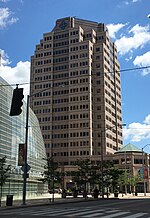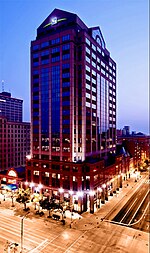KeyBank Tower

KeyBank Tower is a skyscraper in Dayton, Ohio. Its address at 10 West 2nd Street was the first official name of the structure. The building was once named MeadWestvaco Tower until KeyBank gained naming rights to the tower in 2008. The tower has 27 floors and is 117 metres (384 ft) tall. KeyBank occupies about 45,000 square feet of office space spread across four floors of the tower. The main office branch was previously located on the first floor of the tower until it closed in May 2021. Other tenants include National Processing Solutions, Scientific Simulations Systems, Skilken & Skilken, Colliers International, and the Downtown Dayton Partnership.The first floor of the KeyBank Tower also houses an OinkADoodleMoo BBQ restaurant.In 2010, a group of Cincinnati investors purchased KeyBank Tower. The 397,000-square-foot (36,900 m2) building was purchased from THMG 10 West Second Street LLC, a real estate investment company. The company is taking approaches to have the entire office tower leased.
Excerpt from the Wikipedia article KeyBank Tower (License: CC BY-SA 3.0, Authors, Images).KeyBank Tower
West 2nd Street, Dayton
Geographical coordinates (GPS) Address External links Nearby Places Show on map
Geographical coordinates (GPS)
| Latitude | Longitude |
|---|---|
| N 39.760634 ° | E -84.192588 ° |
Address
Key Bank Tower
West 2nd Street 10
45423 Dayton
Ohio, United States
Open on Google Maps








